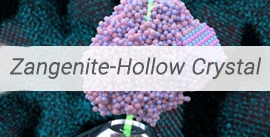 جدید
جدیدنانوساختارهای کربنی از پلیمرهای آلی و فلزات
نانوساختارهای کربنی از پلیمرهای آلی و فلزات
[box type=”shadow” align=”alignright” ]
یک تیم بینالمللی از محقققان شامل فدریکو رسی از Institut National de la Recherche Scientifique (INRS) در کانادا از طریق نشاندن پلیمرهای آلی روی یک زیر لایهی فلزی، راه جدیدی را برای تولید نانوساختارهای کربنی کنترلشده در مقیاس اتمی یافتهاند. چنین نانوساختارهایی میتوانند در الکترونیک مولکولی بر پایه کربن کاربرد پیدا کنند.
[/box]
[box type=”success” width=”1024″ ]تهیه و ترجمه از گروه ترجمه ایران مواد
حرفه ای ترین تیم ترجمه مهندسی مواد ایران
[/box]
در مقالهی منتشر شده در Nature Communications، این محققان نحوه تعیین ساختار کامل الکترونی در پلیمر آلی مزدوج و همچنین تاثیر زیرلایه بر خواص الکترونی آن را توصیف میکنند.
این پژوهشگران از ترکیب دو دستورالعمل – خودگردهمآیی مولکولی و پلیمریزاسیون زنجیرهای – که قبلا در آزمایشگاه رسی ابداع شده بود استفاده کرده و شبکهای از نانوسیمهای بلندبرد از جنس پلی (پارافنیلن) تولید کردند. با استفاده از فناوریهای پیشرفتهای نظیر میکروسکوپ روبشی تونلی و طیفسنجی فوتوالکترونی، و همچنین با بکارگیری مدلهای نظری، آنها موفق شدند مورفولوژی و ساختار الکترونی این نانوساختارها را توصیف کنند.
به گفته رسی: ” ما توانستیم توصیف کاملی از ساختار نواری و همچنین برهمکنش قوی بین پلیمر و زیرلایه ارائه کنیم که هم کاهش نوارممنوعه را توضیح بدهد و هم ساختار فلزی زنجیرههای جدید را.” وی افزود: ” نوارهای PPP در نانوسیمهای پلیمری رسانا حتی در این روش پیوندزنی هم پراکندگی شبه تک-بعدی نشان میدهند.”
گرچه برای توصیف کامل خواص الکترونیکی این نانوساختارها به تحقیقات بیشتری نیاز است، ولی این نوع پراکندگی پلیمر زمینه مشاهده و ثبت طیفی از فرآیندهای پلیمریزاسیون مولکولهای معین روی طلا، نقره، مس و دیگر سطوح را فراهم میکند. این رویکرد برای تحقیقات مشابه درزمینه نیمههادیها نوید بخش است و در واقع، گامی ضروری برای توسعهی دستگاههای حقیقی به شمار میرود.
از نتایج این تحقیق میتوان در طراحی نانوساختارهای آلی که کاربردهای بالقوه مهمی در نانوالکترونیک، از جمله در دستگاههای فوتوولتاییک، ترانزیستورهای اثرمیدانی، دیودهای نشردهندهی نور و حسگرها دارند، استفاده کرد.
[box type=”info” align=”alignright” width=”1124″ ]منبع : materialstoday
ترجمه : حمید رضا شهمیری
مریم آزاده [/box]
[divider]
Carbon nanostructures from organic polymers and metals
By depositing organic polymers on a metal substrate, an international team of researchers including Federico Rosei at the Institut National de la Recherche Scientifique (INRS) in Canada has found a new way to fabricate atomically-controlled carbon nanostructures. Such nanostructures could find use in molecular carbon-based electronics.
In an article published in Nature Communications, the researchers describe determining the complete electronic structure of a conjugated organic polymer and the influence of the substrate on its electronic properties.
The researchers combined two procedures previously developed in Rosei’s lab – molecular self-assembly and chain polymerization – to produce a network of long-range poly(para-phenylene) (PPP) nanowires on a copper surface. Using advanced technologies such as scanning tunneling microscopy and photoelectron spectroscopy, as well as theoretical models, they were then able to describe the morphology and electronic structure of these nanostructures.
“We provide a complete description of the band structure and also highlight the strong interaction between the polymer and the substrate, which explains both the decreased bandgap and the metallic nature of the new chains, ” said Rosei. “Even with this hybridization, the PPP bands display a quasi one-dimensional dispersion in conductive polymeric nanowires.”
Although further research is needed to describe the electronic properties of these nanostructures in full, the polymer’s dispersion provides a spectroscopic record of the polymerization process for certain types of molecules on gold, silver, copper and other surfaces. It’s a promising approach for similar semiconductor studies – an essential step in the development of actual devices.
The results of this study could be used in designing organic nanostructures with significant potential applications in nanoelectronics, including photovoltaic devices, field-effect transistors, light-emitting diodes and sensors.
This story is adapted from material from INRS, with editorial changes made by Materials Today. The views expressed in this article do not necessarily represent those of Elsevier. Link to original source










دیدگاه کاربران